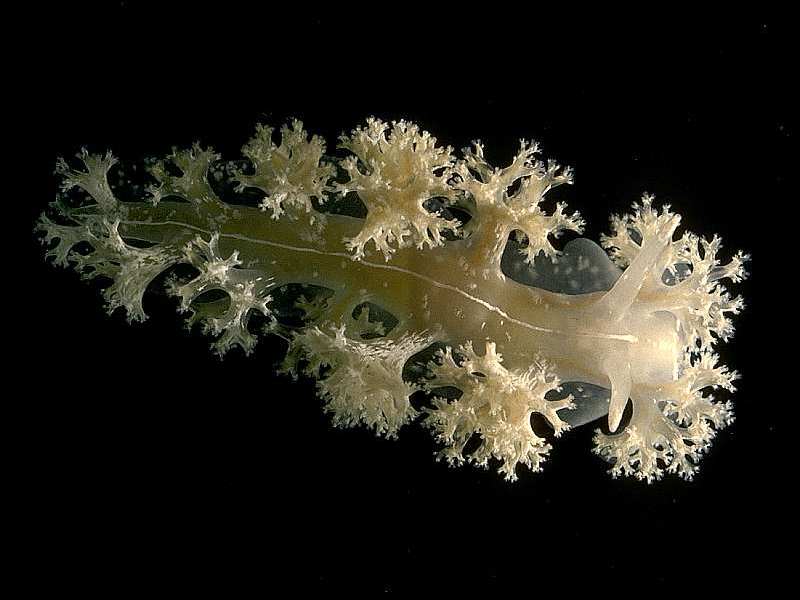Northern Ireland Priority species (NIPS)
| MOLLUSCA : Nudibranchia : Heroidae | SNAILS, SLUGS, ETC. |
Hero formosa (Lovén, 1844)
 |
| Hero formosa |
This sea slug is Rare in Northern Ireland, and possibly under-recorded, being only found off the south-east coast.
In brief
- This species is rare in Northern Ireland, being found only in Strangford Lough or off the Ards Peninsula
- It can only be seen by diving, throughout spring and summer, on wrecks or muddy sand
- It has not been seen since 1988.
Species description: Hero formosa is an unusual looking nudibranch sea slug. The overall body colour is pale pinkish-brown (or white) with white spots scattered down the body and a white centre line along the back. The body reaches a maximum of 40mm in length. It has a single row of up to eight bushy branched appendages down each side of the body and across the front of the head. It has large propodial tentacles at the front of the foot. The erect rhinophores (sensory tentacles) are smooth and finger-like with white tips.
Life cycle: As with all nudibranch sea slugs, Hero formosa is a hermaphrodite. The food is uncertain, although animals have been found associated with various hydroids including Tubularia spp. and Nemertesia ramose. H. formosa has recently been found associated with the deep coral Lophelia pertusa, and therefore may be a deep water species. Spirals of spawn are deposited from April to August, with up to 45,000 ova in each spiral. Hatching develops within 17-19 days at 10oC to give veliger larvae.
Similar species: Hero formosa is superficially similar to Dendronotus frondosus, but easily distinguished by the presence of a white line down its back, and the lack of arborescent rhinophoral sheaths.
How to see this species: This species has only been found in Strangford Lough and off the Ards Peninsula in Northern Ireland, in depths of 10-31m between 1954 and 1988 in March to September. Recent diving observations elsewhere in the UK are from wrecks and muddy sand habitats with scattered shell and rocks, at depths to 60m.
Current status: This species has been recorded from Strangford Lough. Two specimens were dredged in 10m off Island Taggart, on weed in September 1954, two specimens off Killyleagh, 12m, in August 1964, and one specimen off Island Taggart, March 1966 (Queen’s University Belfast). The only other known record is from the wreck of ‘The Bangor’ in May 1988 (J. Nunn) in 31m. It has not been seen since 1988. It is only known elsewhere in the island of Ireland from off Dingle Bay (1890, c. 150m) and Sherky Island County Kerry (August 1995, 32m). It is defined as Nationally Scarce in Great Britain, with most recent records from the Isle of Man, the west coast of Scotland and the Rockall Trough.
Why is this species a priority in Northern Ireland?
- It is scarce with Northern Ireland being an Irish stronghold for the species.
Threats: Threats to this species are unknown, as there is little knowledge of the current populations in Britain and Ireland.
Distribution Map from NBN: Hero formosa at National Biodiversity Network mapping facility, data for UK.
iNaturalist: Hero formosa at iNaturalist World Species Observations database.
WoRMS: Hero formosa at World Register of Marine Species. Accepted name: Hero formosa (Lovén, 1844). AphiaID: 140099.
Classification: Biota; Animalia; Mollusca; Gastropoda; Heterobranchia; Euthyneura; Ringipleura; Nudipleura; Nudibranchia; Cladobranchia; Cladobranchia incertae sedis; Heroidae; Hero
| Previous species | Next species |
| Authors (2024). Hero formosa. (Lovén, 1844). [In] Priority species, Marine Biodiversity Portal NI. https://www2.habitas.org.uk/marbiop-ni/priorityaccounts.php?item=W14420. Accessed on 2025-04-19 |